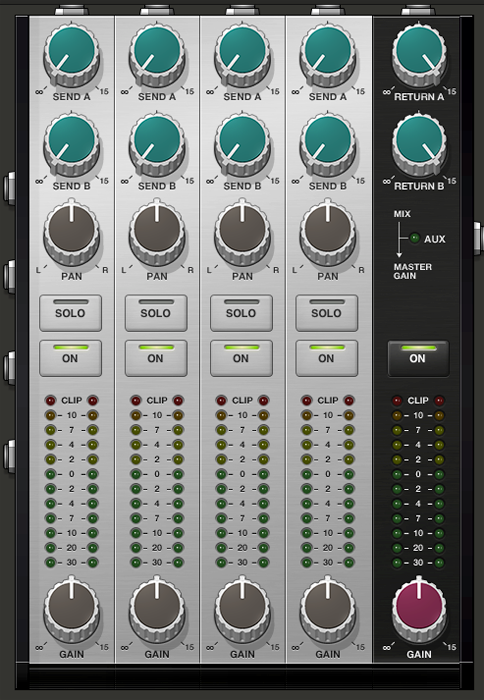We're starting it off with a fairly simple device, but one that's at the center of many Tabletop setups, the Goblin MX4-FX mixer, and as part of the Device Spotlight feature, the MX4-FX is now on sale for only $6.99, marked down from it's regular price of $9.99 for a limited time!

The MX4-FX may only have half as many channels as the MX8 mixer that's included with the Tabletop app, but it's the "FX" part that really makes it stand out. By routing audio out from either of the two "Send" channels on the left side of the mixer, through as many effects as you want, and then back into the matching "Return" channel, you can now control how that effect chain is applied to each channel on the MX4-FX by adjusting the "Send A" and "Send B" knobs on the mixer itself.
Additionally, each MX4-FX you place on the Tabletop surface can actually accept *five* channels of input, the fifth one via the "Aux" input on the right side of the device. However, this channel isn't the same as the other four, in that you can't adjust any of the Send/Pan/Level stuff that you can with the four main channels. It's up to you to decide how you want to use the "Aux" channel in your Tabletop sessions, but one thing that a lot of people have been using it for is routing pre-mixed audio from other mixers. More specifically, you may want to consider dropping two MX4-FX devices right next to each other and routing the output from one in to the "Aux" channel for the other to create you own *eight* channel mixer, before sending that output out to the Mr. O output device or the Recorder M2.

You can check out more example setups like this in the Tabletop demo sessions from Salva, Exilon and others, or check out the Tabletop group on SoundCloud, where many Tabletop users have been sharing screenshots of the setups they've used in their own compositions.
In Exilon's track, the MX4-FX send channels are adjusted throughout the track, gradually rolling entire effect chains on and off with a single knob twist. This works great for live setups where you don't want to be constantly jumping back and forth between several different devices on multiple screens, or by using Tabletop's built in automation features along with the T-101 Triggerator, you can capture these adjustments as part of your finished song composition.
So now that you know a bit more about the MX4-FX, let's see what you can do with it. Post your Tabletop setups & tracks to the SoundCloud group, and let us know in the comments or on Facebook & Twitter what else you'd like to know about this device, or if you have a request for future editions of the Device Spotlight!

Picked up the MX4-FX thanks to this post. I'm looking forward to more device spotlight posts. Keep up the good work on Tabletop — it definitely has dedicated fans.
ReplyDelete